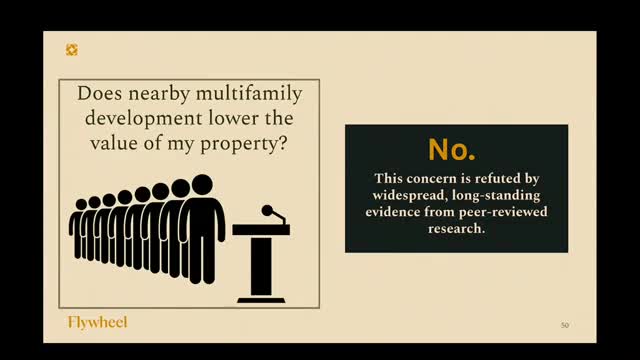Housing Crisis Unveiled as Planning Strategies Face Resistance
June 19, 2024 | Traverse City, Grand Traverse County, Michigan

This article was created by AI summarizing key points discussed. AI makes mistakes, so for full details and context, please refer to the video of the full meeting. Please report any errors so we can fix them. Report an error »

During a recent government meeting, planners and officials addressed the ongoing housing crisis, emphasizing the need for innovative solutions to meet community demands. A significant point of discussion was the frequent rejection of well-planned and zoned housing developments during review meetings, often driven by concerns over property values. However, research presented during the meeting indicated that increased housing typically does not diminish existing property values; rather, it often enhances them by signaling a robust economic environment.
The meeting highlighted a growing consumer preference for walkable, amenity-rich neighborhoods. According to a National Association of Realtors survey, nearly half of potential homebuyers would favor smaller homes in such areas over larger properties in less desirable locations. Despite this demand, less than 3% of Michigan communities currently offer these types of neighborhoods, with Traverse City noted as a standout example.
Planners advocated for a dual approach to development, suggesting that while suburban-style housing is necessary in areas lacking infrastructure, regions with existing sewer and water systems should prioritize denser, walkable developments. This strategy aims to maximize the use of costly infrastructure and cater to the preferences of modern homebuyers.
The meeting also explored the potential for transforming underutilized commercial properties into vibrant residential neighborhoods. For instance, a proposed development in Grand Rapids could increase housing units from 20 to 840, significantly boosting local tax revenues without requiring new infrastructure. This model demonstrates how strategic infill development can enhance community resources and reduce long-term costs.
Concerns about traffic were addressed, with data suggesting that adding new housing in already busy corridors would have a negligible impact on congestion. Moreover, creating denser neighborhoods could encourage alternative transportation options, such as biking and walking, thereby alleviating some traffic issues.
The discussion also touched on the importance of integrating transit solutions into housing development strategies. Thoughtfully deployed transit can incentivize smaller, denser housing and support local commerce, creating a more vibrant community atmosphere.
Finally, the meeting underscored the necessity of layering various programs and initiatives to tackle housing affordability effectively. By combining tax incentives, public financing, and private investment, communities can create diverse housing options that cater to different income levels, ultimately fostering a more inclusive environment.
Overall, the meeting served as a call to action for local governments to rethink their housing strategies, prioritize community needs, and embrace innovative solutions to the housing crisis.
The meeting highlighted a growing consumer preference for walkable, amenity-rich neighborhoods. According to a National Association of Realtors survey, nearly half of potential homebuyers would favor smaller homes in such areas over larger properties in less desirable locations. Despite this demand, less than 3% of Michigan communities currently offer these types of neighborhoods, with Traverse City noted as a standout example.
Planners advocated for a dual approach to development, suggesting that while suburban-style housing is necessary in areas lacking infrastructure, regions with existing sewer and water systems should prioritize denser, walkable developments. This strategy aims to maximize the use of costly infrastructure and cater to the preferences of modern homebuyers.
The meeting also explored the potential for transforming underutilized commercial properties into vibrant residential neighborhoods. For instance, a proposed development in Grand Rapids could increase housing units from 20 to 840, significantly boosting local tax revenues without requiring new infrastructure. This model demonstrates how strategic infill development can enhance community resources and reduce long-term costs.
Concerns about traffic were addressed, with data suggesting that adding new housing in already busy corridors would have a negligible impact on congestion. Moreover, creating denser neighborhoods could encourage alternative transportation options, such as biking and walking, thereby alleviating some traffic issues.
The discussion also touched on the importance of integrating transit solutions into housing development strategies. Thoughtfully deployed transit can incentivize smaller, denser housing and support local commerce, creating a more vibrant community atmosphere.
Finally, the meeting underscored the necessity of layering various programs and initiatives to tackle housing affordability effectively. By combining tax incentives, public financing, and private investment, communities can create diverse housing options that cater to different income levels, ultimately fostering a more inclusive environment.
Overall, the meeting served as a call to action for local governments to rethink their housing strategies, prioritize community needs, and embrace innovative solutions to the housing crisis.
View full meeting
This article is based on a recent meeting—watch the full video and explore the complete transcript for deeper insights into the discussion.
View full meeting
